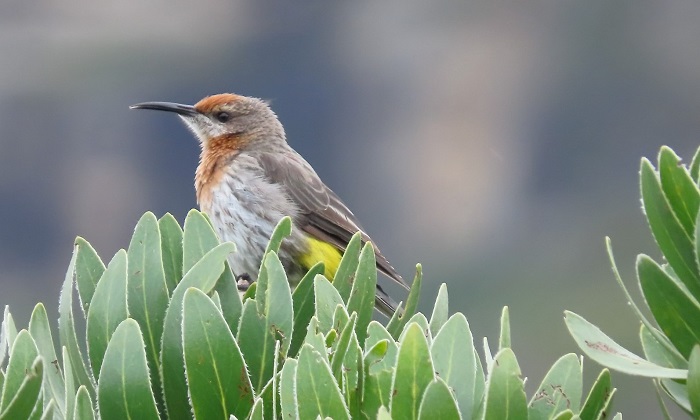Cover image. Gurney’s Sugarbird by Colin Summergill – Carter’s Hill, KwaZulu-Natal – BirdPix No. 252816
Identification
The Gurney’s Sugarbird is an interesting and attractive species, resembling an overgrown sunbird. The sexes are alike in colouration and plumage but males are larger and longer tailed.
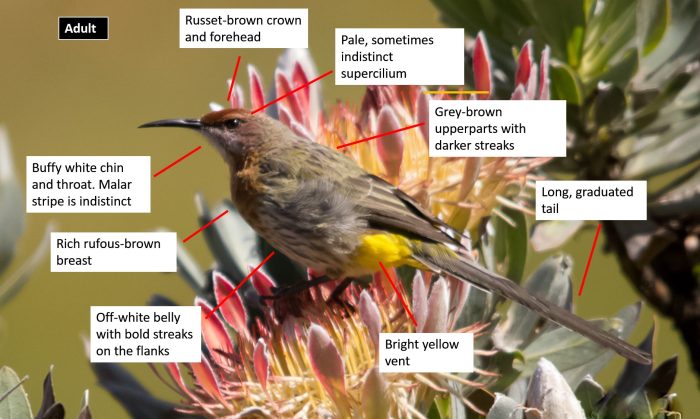
Paardeplaats Farm, Mpumalanga
Photo by Greg Goosen
The head and face are distinctively marked. The forehead and forecrown are russet-brown and the hind crown, neck, lores and ear coverts are greyish-brown. The chin, throat and supercilium are buffy white, and malar stripes are very indistinct or absent. The upper breast is warm, rufous-brown and the lower breast and belly is white, with long, blackish streaks, especially towards the flanks. The vent is bright yellow and conspicuous. The rump is greenish-yellow and best seen in flight. The dark brown tail is long and graduated with a wedge-shaped tip. The bill is black, long and slightly decurved.
Juveniles resemble females but have a plain brown breast (not warm rufous) and the vent is dull yellow.
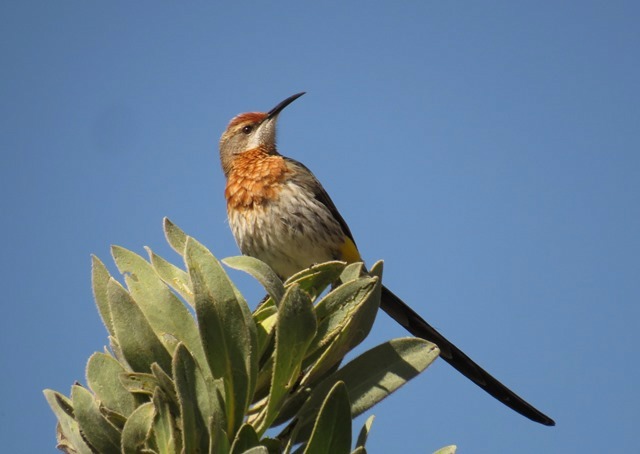
Sani Road, KwaZulu-Natal
Photo by Pamela Kleiman
The Gurney’s Sugarbird is distinctive and unlikely to be mistaken for any other species, with the exception perhaps of the Cape Sugarbird (Promerops cafer). Gurney’s Sugarbird is smaller, shorter tailed and more richly coloured than its Cape relative. The two species have almost exclusive distributions which overlap marginally in the Eastern Cape.
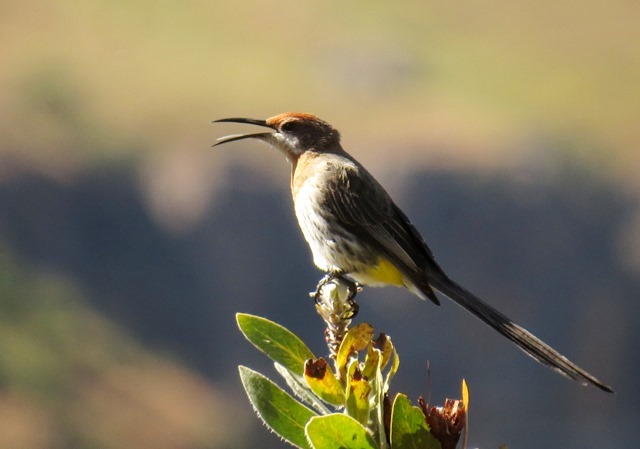
Sani Road, KwaZulu-Natal
Photo by Pamela Kleiman
Status and Distribution
Gurney’s Sugarbird is uncommon to locally common and is endemic to Southern Africa. Its distribution is closely linked to that of the Silver Protea (Protea roupelliae). The core of its range lies along the eastern Drakensberg escarpment from the Eastern Cape to KwaZulu-Natal, extending into the high mountains of the eastern Free State. Scattered populations occur on the mountains between north-central Limpopo Province and north-western Eswatini (Swaziland), including the Waterberg and Soutpansberg ranges. There is an isolated population in the eastern highlands of Zimbabwe and adjacent Mozambique. Historically, its range overlapped with the Cape Sugarbird in the Amatole Mountains, Eastern Cape.

Details for map interpretation can be found here.
The Gurney’s Sugarbird is not currently threatened, but its Protea-savanna habitat is at risk from afforestation. Commercial protea farming in KwaZulu-Natal Midlands provides additional habitat, but the damage caused by birds to flowers could lead to control measures being taken.
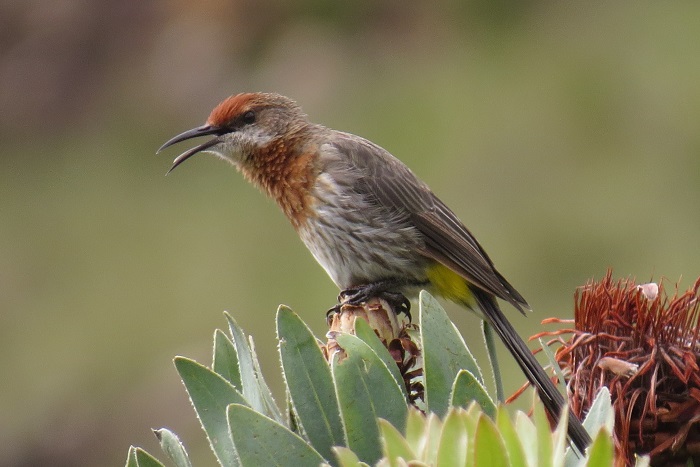
Sani Road, KwaZulu-Natal
Photo by Pamela Kleiman
Habitat
The Gurney’s Sugarbird inhabits montane grassland and scrub in with Protea, Aloe and Strelitzia spp, including areas adjoining Afromontane forest. Distribution in South Africa largely coincides with that of Silver Protea (Protea roupelliae). Often found in gardens and stands of proteas on flower farms in the KwaZulu-Natal Midlands.

Gurney’s Sugarbird (Promerops gurneyi)
Carter’s Hill, KwaZulu-Natal
Photo by Colin Summersgill
Behaviour
Usually encountered solitarily or in pairs, but sometimes in loose groups at a rich food source. Gurney’s Sugarbird is largely sedentary, but moves locally during the non-breeding season. This is either in response to food availability and the flowering phenology of proteas, or moving to lower altitudes in winter.

Giant’s Castle, KwaZulu-Natal
Photo by Alan Manson
Gurney’s Sugarbird feeds mainly on the nectar of Protea species but also from a wide range of tubular-shaped flowers such as Aloes, coral-trees (Erythrina spp), bottlebrushes (Greyia spp), Tree-fuchsia (Halleria lucida), torch lilies (Kniphofia sp), wild daggas (Leonotis spp.) etc. Also takes invertebrates like beetles, bees, ants and spiders and sometimes also consumes pollen.

Goldengate Highlands National Park, Free State
Photo by Ilse Hulme
This species is monogamous and strongly territorial during the breeding season which normally coincides with the peak flowering time of Protea species. The breeding season runs from June to February in KwaZulu-Natal, from November to February in Limpopo and Mpumalanga, and from July to April in Zimbabwe. Males actively chase off rivals and any other nectar-feeding species during this time.
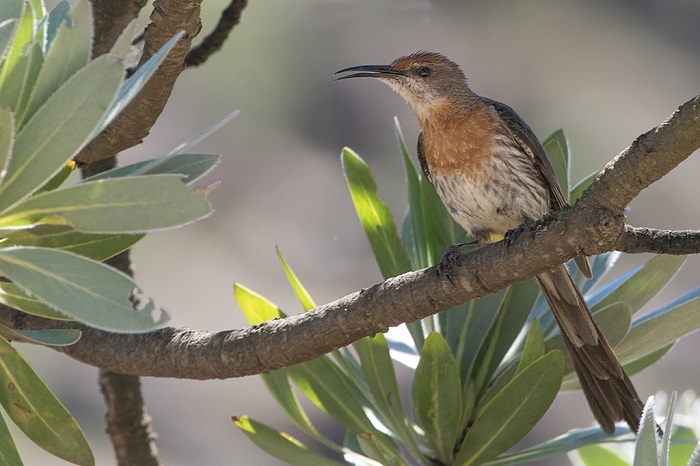
Sani Pass, KwaZulu-Natal
Photo by Gregg Darling
The nest is constructed by the female only with the male staying nearby to protect the territory and nest site. The nest is a loose bowl of twigs, rootlets, grass and bark fibres and is lined with soft grass and the fluffy heads of Protea seeds. The nest is most often situated 1 to 3 m above the ground amongst the branches of Silver Protea (Protea roupelliae) or Common Protea (Protea caffra) trees.
One or two sandy-brown eggs are laid per clutch and incubation begins once the second egg has been laid. The female is responsible for all the incubation duties and the incubation period lasts from 16 to 28 days. The nestlings are fed and cared for by both parents.

Lydenburg district, Mpumalanga
Photo by Dawie De Swardt
Further Resources
Species text adapted from the first Southern African Bird Atlas Project (SABAP1), 1997.
The use of photographs by Alan Manson, Colin Summersgill, Dawie De Swardt, Greg Goosen, Gregg Darling, Ilse Hulme and Pamela Kleiman is acknowledged.
Virtual Museum (BirdPix > Search VM > By Scientific or Common Name).
Other common names: Kaapse suikervoël (Afrikaans); Promérops du Cap (French); Kaapse Suikervogel (Dutch), Kap-Honigfresser (German), Papa-açúcar do Cabo (Portuguese)
Recommended citation format: Tippett RM 2023. Gurney’s Sugarbird Promerops gurneyi. Biodiversity and Development Institute. Available online at http://thebdi.org/2023/08/30/gurneys-sugarbird-promerops-gurneyi/

Goldengate Highlands National Park, Free State
Photo by Ilse Hulme

